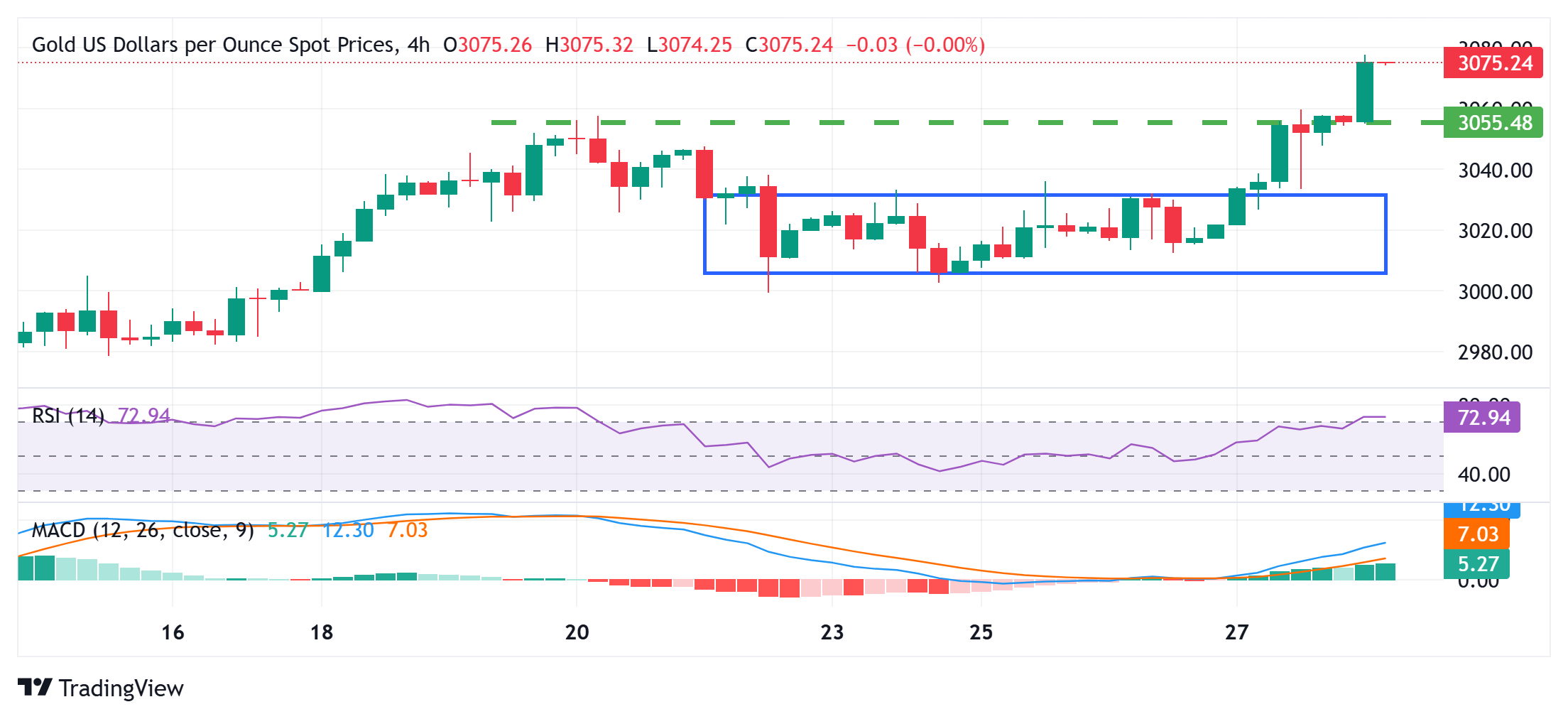Gold prices continue to attract safe-haven inflows amid rising trade tensions.
Fed rate cut bets put dollar bulls on the defensive and provided some support.
Traders are now eyeing the US personal consumption expenditures (PCE) price index for some meaningful impetus.
Gold prices (XAU/USD) attracted follow-through buying for a second day, climbing to a new record high of $3,077-3,078 during the Asian session on Friday. Global risk sentiment was hit by the auto tariffs announced by US President Donald Trump on Wednesday. In addition, uncertainty over Trump's upcoming reciprocal tariffs next week and their impact on the global economy also weighed on investor sentiment. This is seen as a key factor that continues to drive safe-haven flows into precious metals.
Meanwhile, the latest escalation in the trade war has heightened concerns that Trump’s impending reciprocal tariffs will weaken the U.S. economy and force the Federal Reserve (Fed) to resume its rate-cutting cycle soon. This has put dollar bulls on the defensive and has become another factor supporting non-yielding gold prices. However, gold/dollar bulls may take a breather due to slightly overbought conditions, especially ahead of the release of the U.S. personal consumption expenditures (PCE) price index, which should provide clues about the Fed’s rate-cutting path.
U.S. President Donald Trump on Wednesday announced a 25% tariff on imported cars and light trucks, scheduled to take effect on April 3, further expanding the global trade war and curbing investors’ appetite for risky assets.
This, coupled with the 25% fixed tariffs on steel and aluminum, and Trump's upcoming reciprocal tariff announcement next week, further heightened uncertainty and pushed safe-haven gold prices to new record highs.
Meanwhile, the market is now pricing in the possibility that the Federal Reserve (Fed) may cut borrowing costs again at its June policy meeting amid concerns about a tariff-driven slowdown in the U.S. economy.
Dollar bulls seemed to react little to better-than-expected U.S. macro data released on Thursday and hawkish comments from Fed officials, providing additional support for the gold/dollar pair.
The U.S. Bureau of Economic Analysis (BEA) reported that U.S. gross domestic product (GDP) grew at an annualized rate of 2.4% in the fourth quarter, higher than the previous estimate and expectations of 2.3%.
In addition, the U.S. Department of Labor said that new claims for unemployment insurance fell to 224K from a revised 225K last week.
Tom Barkin, president of the Richmond Federal Reserve Bank, said that the current moderately tight monetary policy is appropriate in an environment of uncertainty and rapid changes in US government policies.
Boston Federal Reserve Bank President Susan Collins warned that the Trump administration's aggressive trade policies will push up US inflation, but it is unclear how long this upward pressure will last.
Therefore, market attention remains focused on the upcoming release of the US Personal Consumption Expenditures (PCE) price index, the Federal Reserve's preferred inflation indicator, which is expected to be released in the early North American trading hours.
Investors will carefully scrutinize this key data to assess the trajectory of further rate cuts, which will affect the US dollar price dynamics and provide new impetus for non-yielding gold.

From a technical perspective, this week’s bullish resilience around the psychological $3,000 mark and subsequent gains suggest that the path of least resistance for gold prices remains to the upside. However, the RSI on the daily chart has shown overbought conditions, warranting some caution. Therefore, it would be wise to wait for some short-term consolidation or a modest pullback before positioning for a continuation of the nice uptrend seen over the past three months or so.
Meanwhile, any corrective declines seem to be able to attract some dip buying around the $3,050-3,048 levels for now. This should help limit the downside for gold prices around $3,036-3,035. However, a sustained break above the latter could trigger some technical selling and drag XAU/USD to medium-term support at $3,020-3,019, back towards the $3,000 mark. This mark should serve as a key turning point for short-term traders and, if decisively breached, could pave the way for a significant near-term decline.
Gold has played a key role in human history as it is widely used as a store of value and medium of exchange. Currently, in addition to its lustre and use in jewellery, gold is widely viewed as a safe haven asset, meaning it is considered a good investment in turbulent times. Gold is also widely viewed as a hedge against inflation and currency debasement as it is not dependent on any particular issuer or government.
Central banks are the largest holders of gold. To support their currencies during turbulent times, central banks tend to diversify their reserves and buy gold to boost perceptions of economic and monetary strength. High gold reserves can be a source of confidence in a country's solvency. According to the World Gold Council, central banks added 1,136 tons of gold reserves in 2022, worth about $70 billion. This is the highest annual purchase on record. Central banks in emerging economies such as China, India and Turkey are rapidly increasing their gold reserves.
Gold is negatively correlated with the U.S. dollar and U.S. Treasuries, both of which are major reserve assets and safe havens. Gold tends to rise when the dollar depreciates, allowing investors and central banks to diversify their assets during turbulent times. Gold is also negatively correlated with risky assets. Stock market rebounds tend to push gold prices lower, while sell-offs in riskier markets tend to benefit gold.
Prices can move due to a wide variety of factors. Geopolitical instability or fears of a deep recession could quickly push gold prices higher due to its safe-haven status. As a low-yielding asset, gold tends to rise as interest rates fall, while higher funding costs usually weigh on gold. Still, since the asset is priced in U.S. dollars (XAU/USD), most movements depend on the performance of the U.S. dollar (USD). A strong dollar tends to control gold prices, while a weak dollar can push them higher.